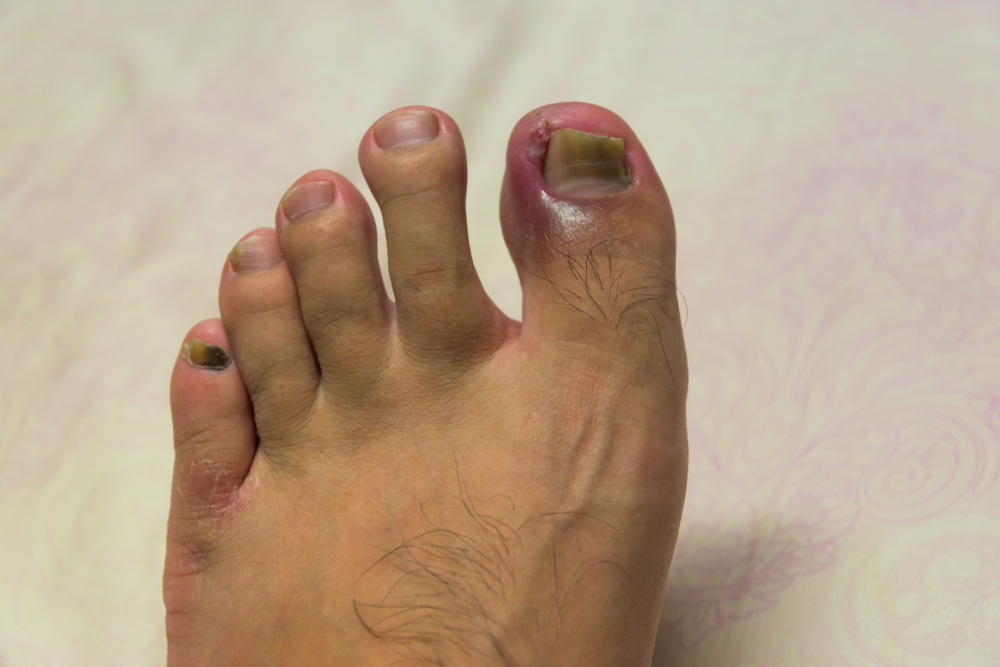Toenail paronychia is a bacterial infection that produces stabbing pain and pus buildup near the toenail.
Acute paronychia is caused by a bacterial infection, like staphylococcus aureus or streptococcus, while chronic paronychia develops slowly as a result of the candida bacteria.
In the case of acute paronychia, it should be treated by a health care expert, such as a podiatrist, as soon as possible due to the fast progression of symptoms.
This article explains what paronychia is and how to cure it.
The various phases of paronychia
Although paronychia is most frequently associated with the fingers, it can also be a toe infection.
From inoculation to the need for treatment, paronychia usually goes through 3 phases, which are listed below:
- The inflammation phase: The infection is still reversible at this point, but it must be treated quickly to avoid consequences.
- The “colonization” phase: This stage of infection is quite similar to the previous one. The symptoms, on the other hand, are much more prevalent. In most cases, upon reaching this point, the patient will require the intervention of a podiatrist to remove the pus that has accumulated and therefore prevent the illness from worsening.
- The complication phase (infection): If the paronychia is not properly treated, the infection might spread to other foot structures. The onset of this phase necessitates a considerably more intrusive diagnosis and treatment than the “colonization” phase.
Symptoms of toenail paronychia
Once the bacteria that causes paronychia makes its way onto or beneath the skin of the toe, the infection spreads swiftly.
The following signs characterize the earliest indications of infection:
- Redness in the toe, around the nail;
- A feeling of heat in the affected area;
- Swelling of the toe;
- Pain to the touch.
The symptoms may increase if therapy is not given within the first few days after seeing them.
They then appear as:
- A significant increase in pain, which becomes throbbing;
- Production and accumulation of pus around the toenail;
- A fever higher than 38 degrees Celsius.
The symptoms described above are likely to increase after a week without treatment, necessitating emergency medical attention.
These symptoms could then become:
- The spread of the condition to surrounding tissue;
- Joint infection of the toe;
- Tendon damage;
- Osteitis (infection of the phalanx);
- Complete destruction of the nail matrix (rarer in adults);
- Tissue necrosis.
Similar foot diseases
As we’ve seen, paronychia’s viral nature can cause several very common symptoms.
As a result, many different bacterial infections can elicit symptoms that are similar to paronychia.
This can be true for:
- Onychocryptosis (ingrown toenail);
- Fungus on the nails;
- Athlete’s foot (tinea pedis).
The podiatrist performs a variety of diagnostic procedures to verify that he or she is treating the correct problem.
Visual inspection, digital x-rays of the foot, and ultrasound are some of the methods used.
Causes and risk factors
Because paronychia is caused by bacteria, it always starts with an open toe lesion.
If it happens around the nail, one of the following scenarios is likely at the root:
- A poorly performed pedicure;
- Trauma or shock to the foot that causes the skin to pull away;
- The presence of a foreign body under the nail, such as a splinter or rock;
- A nail that is cut too short or an ingrown toenail;
- An insect bite;
- Shoes that are too tight.
Naturally, some people are more vulnerable to the impacts of a disease than others. This is especially true if the patient has diabetes or has a compromised immune system.
Cleaning the wound or removing the splinter that is causing the toe pain should be one of the first things you do in any situation.
Medical treatments for paronychia
Medical treatment is almost always required if paronychia has progressed to a more severe phase.
In addition to providing a diagnosis, the podiatrist can devise a treatment plan to alleviate the foot pain.
The following are some of the less intrusive options available:
- Foot care, which includes antiseptic baths, nail trimming and protective bandaging;
- Prescription of antibiotics to combat streptococcus and staphylococcus aureus.
For more difficult cases, the podiatrist’s recommendations are more geared toward:
- Surgical drainage of the purulent abscess, done under local anesthesia;
- Total or partial removal of the nail;
- Removal of the foreign body that is causing the paronychia;
- More rarely, surgical excision of necrotic tissue.
PiedReseau – Learn more
Do you want to learn more about toe infections such as paronychia? This is a topic on which we publish information on a regular basis!
Even if our platform delivers useful information, nothing matches a face-to-face consultation with a PiedReseau-affiliated podiatrist.
Take care of your feet, they’re precious!

